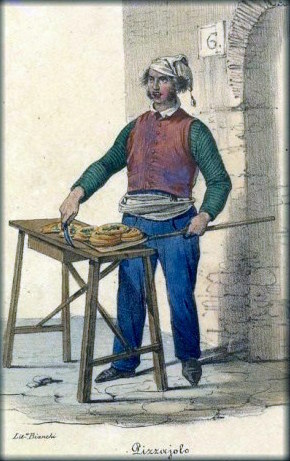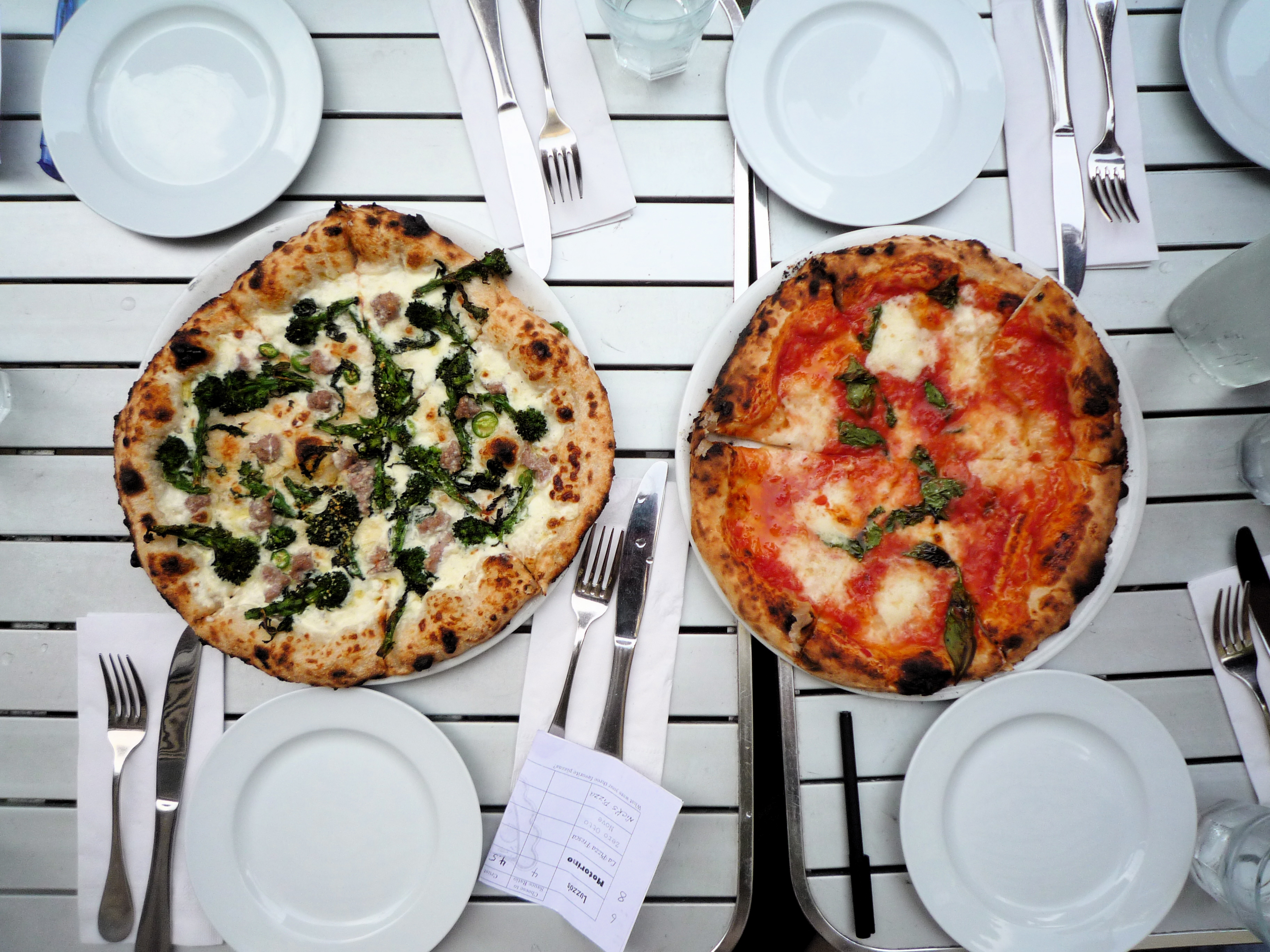|
Pissaladière
Pissaladière (, , ; oc, label= Niçard, pissaladiera or ; lij, piscialandrea ) is a dish of flatbread with toppings in the cuisines of Liguria (especially Genoa) and Nice. It is often compared to pizza. The dough is usually a bread dough thicker than that of the classic pizza Margherita, and the traditional topping usually consists of caramelised (almost pureed) onions, black olives, and anchovies (whole, and sometimes also with pissalat, a type of anchovy paste).Julia Child (1961) ''Mastering the Art of French Cooking'' Vol. 1, Alfred A. Knopf, New York This dish subsequently spread to the whole of geographic and ethno-cultural Liguria, that is to say between the rivers of Magra and Var. After the annexation of the County of Nice to France, this dish of Ligurian origin became established in French cuisine. Etymology The etymology of the word seems to originate from the Latin ''piscis'' "fish", which in turn originated ''pissalat'', the name of an anchovy paste (via ''peis sa ... [...More Info...] [...Related Items...] OR: [Wikipedia] [Google] [Baidu] |
Ligurian Cuisine
Ligurian cuisine consists of dishes from the culinary tradition of Liguria, a region of northwestern Italy, which makes use of ingredients linked both to local production (such as preboggion, a mixture of wild herbs), and to imports from areas with which, over the centuries, the Ligurians have had frequent trade (such as Sardinian pecorino, one of the ingredients of pesto). Characteristics Ligurian cuisine is affected by the geomorphological characteristics of its territory. It makes use of ingredients coming from the sea as well as game and meat. Ligurian cuisine has transformed over the centuries in relation to the socio-economic situation of the region. The scarcity of cattle pastures forced the Ligurians to develop dishes based on alternative ingredients such as fish and herbs, to which game was subsequently added. Ligurians pair their meat condiments based on wild or cultivated herbs, among which pesto stands out, which is used both as a sauce for ... [...More Info...] [...Related Items...] OR: [Wikipedia] [Google] [Baidu] |
Niçoise Cuisine
Nice ( , ; Niçard: , classical norm, or , nonstandard, ; it, Nizza ; lij, Nissa; grc, Νίκαια; la, Nicaea) is the prefecture of the Alpes-Maritimes department in France. The Nice agglomeration extends far beyond the administrative city limits, with a population of nearly 1 millionDemographia: World Urban Areas , Demographia.com, April 2016 on an area of . Located on the , the southeastern coast of France on the , at the foot of the |
Cuisine Of Liguria
Ligurian cuisine consists of dishes from the culinary tradition of Liguria, a region of northwestern Italy, which makes use of ingredients linked both to local production (such as preboggion, a mixture of wild herbs), and to imports from areas with which, over the centuries, the Ligurians have had frequent trade (such as Sardinian pecorino, one of the ingredients of pesto). Characteristics Ligurian cuisine is affected by the geomorphological characteristics of its territory. It makes use of ingredients coming from the sea as well as game and meat. Ligurian cuisine has transformed over the centuries in relation to the socio-economic situation of the region. The scarcity of cattle pastures forced the Ligurians to develop dishes based on alternative ingredients such as fish and herbs, to which game was subsequently added. Ligurians pair their meat condiments based on wild or cultivated herbs, among which pesto stands out, which is used both as a sauce for ... [...More Info...] [...Related Items...] OR: [Wikipedia] [Google] [Baidu] |
Cuisine Of Provence
Provence (, , , , ; oc, Provença or ''Prouvènço'' , ) is a geographical region and historical province of southeastern France, which extends from the left bank of the lower Rhône to the west to the France–Italy border, Italian border to the east; it is bordered by the Mediterranean Sea to the south. It largely corresponds with the modern administrative Regions of France, region of Provence-Alpes-Côte d'Azur and includes the Departments of France, departments of Var (department), Var, Bouches-du-Rhône, Alpes-de-Haute-Provence, as well as parts of Alpes-Maritimes and Vaucluse.''Le Petit Robert, Dictionnaire Universel des Noms Propres'' (1988). The largest city of the region and its modern-day capital is Marseille. The Ancient Rome, Romans made the region the first Roman province beyond the Alps and called it ''Provincia Romana'', which evolved into the present name. Until 1481 it was ruled by the List of rulers of Provence, Counts of Provence from their capital in Aix- ... [...More Info...] [...Related Items...] OR: [Wikipedia] [Google] [Baidu] |
Pizza Varieties
Pizza (, ) is a dish of Italian origin consisting of a usually round, flat base of leavened wheat-based dough topped with tomatoes, cheese, and often various other ingredients (such as various types of sausage, anchovies, mushrooms, onions, olives, vegetables, meat, ham, etc.), which is then baked at a high temperature, traditionally in a wood-fired oven. A small pizza is sometimes called a pizzetta. A person who makes pizza is known as a pizzaiolo. In Italy, pizza served in a restaurant is presented unsliced, and is eaten with the use of a knife and fork. In casual settings, however, it is cut into wedges to be eaten while held in the hand. The term ''pizza'' was first recorded in the 10th century in a Latin manuscript from the Southern Italian town of Gaeta in Lazio, on the border with Campania. Modern pizza was invented in Naples, and the dish and its variants have since become popular in many countries. It has become one of the most popular foods in the world and ... [...More Info...] [...Related Items...] OR: [Wikipedia] [Google] [Baidu] |
Pizza
Pizza (, ) is a dish of Italian origin consisting of a usually round, flat base of leavened wheat-based dough topped with tomatoes, cheese, and often various other ingredients (such as various types of sausage, anchovies, mushrooms, onions, olives, vegetables, meat, ham, etc.), which is then baked at a high temperature, traditionally in a wood-fired oven. A small pizza is sometimes called a pizzetta. A person who makes pizza is known as a pizzaiolo. In Italy, pizza served in a restaurant is presented unsliced, and is eaten with the use of a knife and fork. In casual settings, however, it is cut into wedges to be eaten while held in the hand. The term ''pizza'' was first recorded in the 10th century in a Latin manuscript from the Southern Italian town of Gaeta in Lazio, on the border with Campania. Modern pizza was invented in Naples, and the dish and its variants have since become popular in many countries. It has become one of the most popular foods in the world and a ... [...More Info...] [...Related Items...] OR: [Wikipedia] [Google] [Baidu] |
Flatbread
A flatbread is a bread made with flour; water, milk, yogurt, or other liquid; and salt, and then thoroughly rolled into flattened dough. Many flatbreads are unleavened, although some are leavened, such as pizza and pita bread. Flatbreads range from below one millimeter to a few centimeters thick so that they can be easily eaten without being sliced. They can be baked in an oven, fried in hot oil, grilled over hot coals, cooked on a hot pan, tava, comal, or metal griddle, and eaten fresh or packaged and frozen for later use. History Flatbreads were amongst the earliest processed foods, and evidence of their production has been found at ancient sites in Mesopotamia, ancient Egypt, and the Indus civilization. In 2018, charred bread crumbs were found at a Natufian site called Shubayqa 1 in Jordan (in Harrat ash Shaam, the Black Desert) dating to 12,400 BC, some 4,000 years before the start of agriculture in the region. Analysis showed that they were probably from flatbread cont ... [...More Info...] [...Related Items...] OR: [Wikipedia] [Google] [Baidu] |
Appetizers
An hors d'oeuvre ( ; french: hors-d'œuvre ), appetiser or starter is a small dish served before a meal in European cuisine. Some hors d'oeuvres are served cold, others hot. Hors d'oeuvres may be served at the dinner table as a part of the meal, or they may be served before seating, such as at a reception or cocktail party. Formerly, hors d'oeuvres were also served between courses.''Oxford English Dictionary'', First Edition, 189''s.v.''/ref> There are two types of hors d'oeuvre from service point of view: # General hors d'oeuvre # Classical hors d'oeuvre General hors d'oeuvres include cold preparations such as salad, cold meat, and fish. Classical hors d'oeuvres include fruit juice and soft drinks, grapefruit, shellfish cocktail, and so on. Typically smaller than a main dish, an hors d'oeuvre is often designed to be eaten by hand. Etymology in French literally means "outside the work"; that is, "not part of the ordinary set of courses in a meal". In practice, it is ... [...More Info...] [...Related Items...] OR: [Wikipedia] [Google] [Baidu] |
List Of Italian Dishes
This is a list of Italian dishes and foods. Italian cuisine has developed through centuries of social and political changes, with roots as far back as the 4th century BC. Italian cuisine has its origins in Etruscan, ancient Greek, and ancient Roman cuisines. Significant changes occurred with the discovery of the New World and the introduction of potatoes, tomatoes, bell peppers and maize, now central to the cuisine but not introduced in quantity until the 18th century. The cuisine of Italy is noted for its regional diversity, abundance of difference in taste, and is known to be one of the most popular in the world, with influences abroad. Pizza and spaghetti, both associated with the Neapolitan traditions of cookery, are especially popular abroad, but the varying geographical conditions of the twenty regions of Italy, together with the strength of local traditions, afford a wide range of dishes. Dishes and foods The cuisine of Italy has many unique dishes and foods. Zuppe ... [...More Info...] [...Related Items...] OR: [Wikipedia] [Google] [Baidu] |
County Of Nice
The County of Nice (french: Comté de Nice / Pays Niçois, it, Contea di Nizza/Paese Nizzardo, Niçard oc, Contèa de Niça/País Niçard) is a historical region of France located around the southeastern city of Nice and roughly equivalent to the modern arrondissement of Nice. History Its territory lies between the Mediterranean Sea (Côte d'Azur), Var River and the southernmost crest of the Alps. Ligurian tribes populated the County of Nice prior to its occupation by the Romans. These tribes, conquered by Augustus, had become fully Romanized (according to Theodore Mommsen) by the 4th century, when the barbarian invasions began. In those Roman centuries, the area was part of the ''Regio IX Liguria'' of Italy. The Franks conquered the region after the Fall of the Western Roman Empire, and the local Romance populations became integrated within the County of Provence, with a period of independence as a maritime republic (1108–1176). It was initially a semi-autonomous p ... [...More Info...] [...Related Items...] OR: [Wikipedia] [Google] [Baidu] |
Var (river)
The Var (, ; it, Varo; la, Varus) is a river located in the southeast of France. It is long. Its drainage basin is .Bassin versant : Var (Le) Observatoire Régional Eau et Milieux Aquatiques en PACA The Var flows through the '''' for most of its length, with a short (~15 km or ~9 mi) stretch in the département. It is a unique case in Fran ... [...More Info...] [...Related Items...] OR: [Wikipedia] [Google] [Baidu] |






_(2).jpg)
